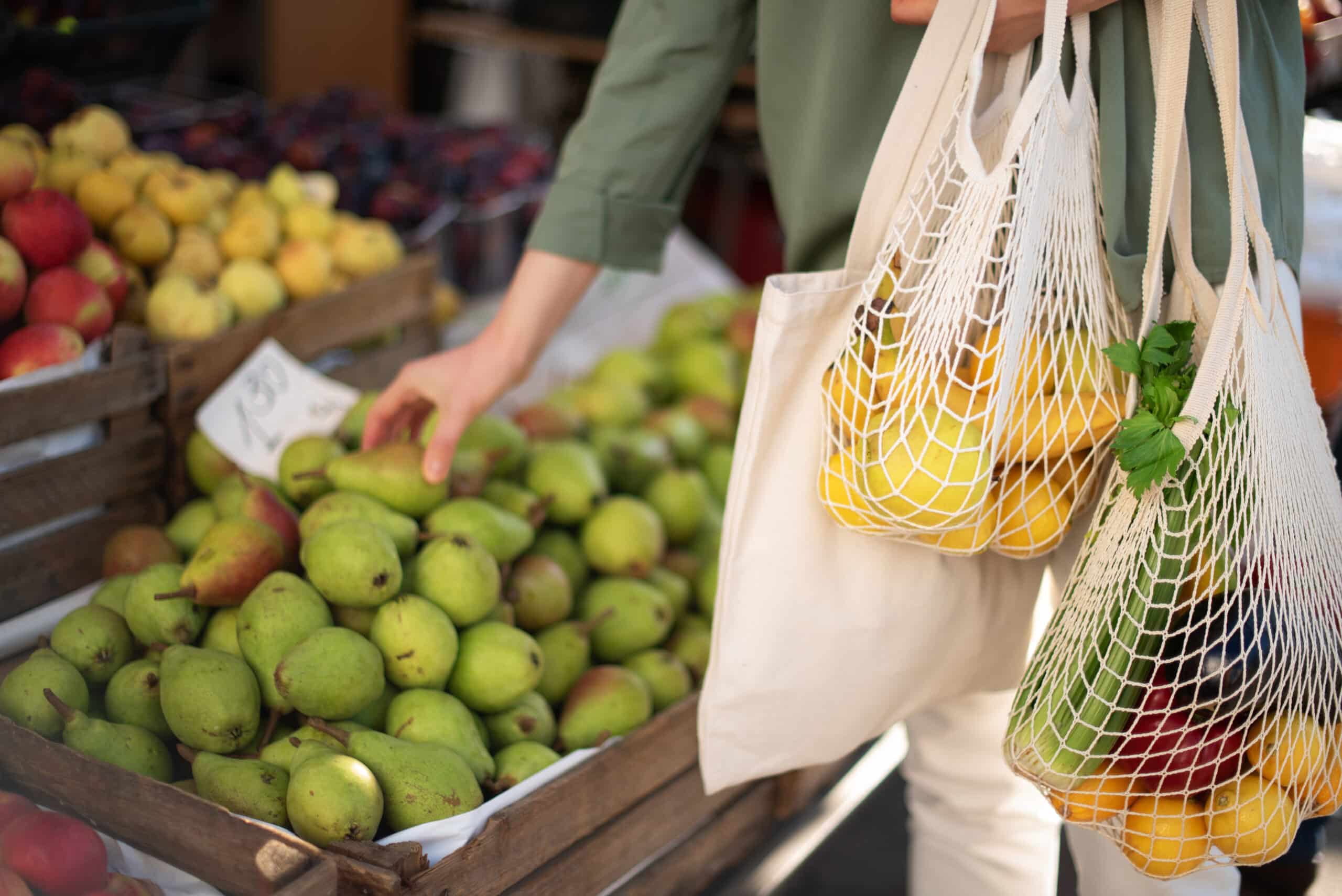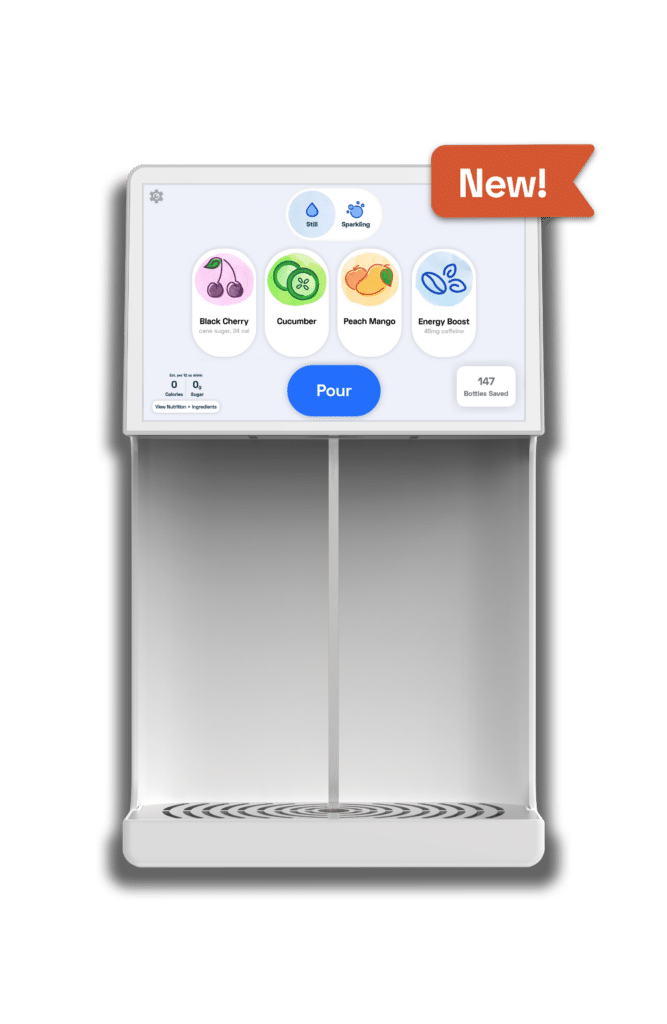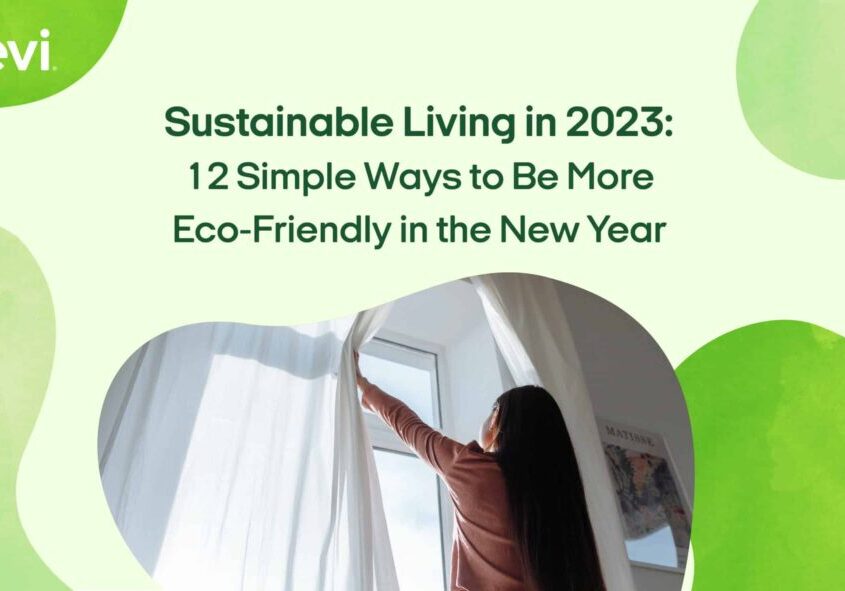The beginning of a new year is a time for celebration, reminiscing, and of course—a time for setting positive intentions as we gear up for another 365 days on our miraculous (but fragile) planet Earth.
If one of your New Year’s resolutions is to become more eco-friendly and make greener choices, let’s look at a few small changes you can make that will add up to a larger ecological impact over the course of 2023.
Without further ado, here is how to be more eco friendly
1. Buy a reusable water bottle

Switching out cases of water for a reusable bottle is a great first step towards reducing your plastic footprint in 2023.
It’s estimated that on average, Americans spend $260 a year on single-use water bottles to fulfill their hydration needs. By switching to a reusable water bottle, you’ll not only save money in the long run, but you’ll also be eliminating single-use plastics from entering the landfill.
When shopping for a reusable water bottle, you have quite a few options to choose from. If drinking more water is a goal for you in 2023, search for a bottle that you know you’ll reach for, such as the Hydro Flask 32-Ounce Wide Mouth Bottle that features a flexible straw lid for easy sipping. For a budget-friendly option, we also love Ello’s Cooper Stainless Steel Water Bottle.
2. Encourage your place of work to buy a bottleless water dispenser

If you work somewhere that frequently stocks the fridge with cases of Poland Springs and LaCroix seltzer, consider reaching out to your office manager about switching to a smart water cooler like Bevi.
In addition to reducing your carbon footprint and saving thousands and thousands of bottles and cans annually with a Bevi machine, your workplace can save on beverage costs, too. On average a glass of water from the Bevi machine costs less than half of what you’d pay for bottled water. Plus, Bevi offers a variety of delicious flavors made from all-natural ingredients, such as Peach Mango, Strawberry Lemongrass, and Coconut. You can even add enhancements to your beverage like Immunity and Caffeine!
With over 48,000 possible drink combinations, you and your coworkers will enjoy a personalized hydration experience while keeping harmful, non-biodegradable plastics out of the oceans.
3. Use your own travel cup at your local coffee shop

How to be more eco-friendly this year? Ditch the disposable cups and straws.
Though many coffee shops paused their reusable cup programs during the COVID-19 pandemic, some of them are now making a full comeback. This is great news considering the United States alone uses 130 billion disposable cups a year, including coffee cups. In addition to being made from materials that harm our planet, these cups also take a lot of energy to manufacture, leading to more harmful emissions in the air.
Many large coffee chains such as Starbucks and Peet’s Coffee offer $0.10 discounts to those who bring in their own clean, reusable cups. It may not seem like much, but if you enjoy stopping for a coffee a few times a week, these costs do add up. Plus you’ll be helping out the planet one cup of coffee or tea at a time.
It’s worth noting that not every coffee shop allows customers to bring in their own reusable cups, so we recommend reaching out to your favorite store first to confirm!
4. Bring reusable bags to the grocery store

There’s a good reason why many communities are implementing plastic bag bans. Not only do plastic bags spoil the landscape and harm our marine life with their non-biodegradable properties, but they’re also flimsy and can’t hold as many groceries compared to reusable alternatives.
When researching reusable bags, consider your own shopping needs. If you tend to buy a lot of groceries each week, go with a bag that offers plenty of space and can hold all your heavy ingredients without worry, such as CleverMade’s Collapsible LUXE Tote. If you own a sewing machine and want to get crafty, you can make your own bags in fun fabrics and colors!
5. Ditch the straws (or invest in reusable ones)

Next time you’re out for drinks or grabbing an iced coffee at your local coffee shop, ask the bartender or the barista to skip the straw. If you rely on straws because of a disability, you can buy a reusable straw made out of stainless steel, bamboo, or glass to bring with you on-the-go. Look for straws that are collapsible and come with a carrying case for extra convenience!
6. Switch to shampoo and conditioner bars

Not-so-fun-fact: plastic shampoo and conditioner bottles can take up to 450 years to decompose once they hit the landfill. We may love the convenience of picking up a bottle of shampoo from the grocery store shelves, but these containers are damaging to our planet.
By switching to shampoo and conditioner bars, you could assist in keeping 15 bottles out of landfills per year. Plus, many shampoo bars on the market are paraben-free, cruelty-free, and gentle for all hair types.
If you’re looking to make the switch but unsure where to begin, take a look through The Earthling Co’s line of shampoo and conditioner bars to find what works best for you!
7. Experiment with different modes of transportation to get around town

With carbon levels at their highest in human history, it’s all hands on deck to cut our greenhouse gas emissions. One way you can do this in 2023 is by choosing more sustainable modes of transportation.
The concept of sustainable transportation looks a bit different for everyone, especially considering varying commuting types and living environments. For example, if you live in a large city with multiple transportation options, consider a bike-rental program in the warmer months while taking the subway or bus in the winter.
If you have a long commute to your place of work and your town doesn’t have much public transit, try carpooling with a coworker to reduce the number of cars on the road.
8. Cut down on online shopping to decrease packaging waste

While online shopping is super convenient, the amount of packaging waste produced each year is staggering. One report alleges that in 2021, Amazon generated over 300 million kilograms of plastic packaging. If all of this waste were laid out, it would circle the Earth more than 800 times. Yikes.
So, what can you do to help? Spend more time in physical stores and less time adding things to your virtual shopping cart. In addition to cutting down on unnecessary bubble wrap and air-pillows, you’ll also find more enjoyment from browsing the aisles and window shopping with friends and family.
Of course, there may be times when online shopping is the easier option, especially if you’re in a time crunch or don’t have the ability to travel to your favorite retailers. In this case, save your cardboard boxes and bubble wrap for future use. They may come in handy if you have to ship fragile items or are planning a big move.
9. Use natural light as much as possible

Let’s face it–nobody enjoys ripping into the envelope that holds their electric bills each month. In the age of convenience and smart technology, we tend to use up a lot of power to complete our day-to-day tasks.
One way to combat a high electricity bill and be more environmentally conscious is to use natural light whenever possible. Open up your blinds and pull back your curtains on sunny days to avoid using artificial light. If the weather is nice and you want to save even more money (and energy!), open your windows to cool down your home instead of reaching for the fan or air conditioner.
10. Shop at bulk-food stores

Research shows that 14 million tons of plastic packaging for food products end up in our oceans each year. This includes the packaging we typically see on grocery store shelves such as corrugated boxes holding our favorite cereal and pasta, plastic jars filled with nuts and legumes, and bags of coffee beans.
Whenever possible, try buying these items in bulk or at a package-free store where you can bring your own reusable containers. Plus, you’re less likely to overspend or waste products if you only purchase the quantities you need.
11. Buy second-hand clothes

When we think of “going green” we typically think of cutting down on single-use plastic and reducing our carbon emissions. But what about the fashion industry? It turns out that nearly 10% of microplastics dispersed into our oceans each year come from textiles. On top of that, it’s estimated that the average American consumer disposes of 81.5 pounds of clothing each year.
So, what can you do to fight the fast-fashion industry? Shop second-hand whenever you are in the market for a new article of clothing. Not only will this extend the product’s life-cycle, but you’ll also be slowing down the rate of excessive consumption—meaning much less waste in the landfill.
12. Purchase eco-friendly cleaning supplies

Engaging in a productive cleaning session over the weekend can leave you and your home feeling great, but it can also create a lot of waste. Between paper towels, plastic bottles, and chemicals that need to be handled carefully, it’s not always an environmentally-friendly endeavor.
It doesn’t have to be that way, though. There are now alternatives for most of the classic cleaning supplies you keep under the kitchen sink. Check out EcoWatch’s friendliest cleaning supplies of 2022, where they offer suggestions for multi-purpose cleaners, glass cleaners, dish soaps, and even reusable “paper” towels.
Ready to go green this year?
Every decision made with sustainability in mind really adds up to protecting our future, and we’ll be right there with you next year doing our best to care for each other and the environment.
Have any sustainable resolutions of your own to add to the list? We’d love to hear from you on Facebook, Instagram, Twitter, or LinkedIn!






